Grumman F-9 Cougar Video - Crash landing aboard USS INtrepid (CVA-11) 1956
More Grumman F-9 Cougar Videos 1 2 - Grumman F-9 Cougar Pictures
|
|
|
|
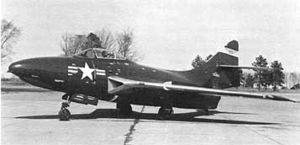 Role - Fighter aircraft
Role - Fighter aircraft
National origin - United States
Manufacturer - Grumman
First flight - 20 September 1951
Retired - 1974, US Navy
Primary users - United States Navy
United States Marine Corps
Argentine Navy
Developed from - F9F Panther
The Grumman F9F/F-9 Cougar was an aircraft carrier-based fighter aircraft for the United States Navy. Based on the earlier Grumman F9F Panther, the Cougar replaced the Panther's straight wing with a more modern swept wing. The Navy considered the Cougar an updated version of the Panther, despite having a different official name, and thus Cougars started off from F9F-6 upwards.
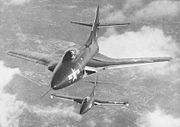 Design and development
Design and development
Picture: A swept-wing F9F-6 Cougar (foreground) and a straight-wing F9F-5 Panther in flight
Prototypes were quickly produced by modifying Panthers, and the first (XF9F-6) flew on 20 September 1951. The aircraft was still subsonic, but the critical Mach number was increased from 0.79 to 0.86 at sea level and to 0.895 at 35,000 ft (10,000 m), improving performance markedly over the Panther. The Cougar would not be outclassed by Russian Mikoyan-Gurevich MiG-15s, but it was to-late to see Korean war service.
Initial production (646 airframes) was the F9F-6, delivered from mid 1952 through July 1954. Armament was four 20 mm (.79 in) M2 cannons in the nose and provision for tw-1,000 lb (454 kg) bombs or 150 US gal (570 l) drop tanks under the wings. Most were fitted with a UHF homing antenna under the nose, and some were fitted with probes for inflight refuelling. Later redesignated F-9F in 1962. Sixty were built as F9F-6P reconnaissance aircraft with cameras instead of the nose cannon.
After withdrawal from active service, many F9F-6s were used as unmanned drones for combat training, designated F9F-6K, or as drone directors, designated F9F-6D. The F9F-6K and the F9F-6D were redesignated the QF-9F and DF-9F, respectively.
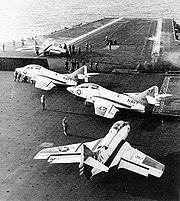 Picture:
Launch of the last USN TF-9Js from USS John F. Kennedy, 1974
Picture:
Launch of the last USN TF-9Js from USS John F. Kennedy, 1974
F9F-7 referred to the next batch of Cougars that were given the Allison J33 engine instead of the Pratt & Whitney J48. 168 were built, but the J33 proved both less powerful and less reliable than the J48. Almost all were converted to take J48s, and were thus indistinguishable from F9F-6s. These were redesignated F-9H in 1962.
The F9F-8 was the final fighter version. It featured an 8 in (20 cm) stretch in the fuselage and modified wings with greater chord and wing area, to improve low-speed, high angle of attack flying and to give more room for fuel tanks. 601 aircraft were delivered between April 1954 and March 1957; most were given inflight refuelling probes, and late production were given the ability to carry four AIM-9 Sidewinder air-to-air missiles under the wings. Most earlier aircraft were modified to this configuration. A number were given nuclear bombing equipment. These were redesignated F-9J in 1962.
The F9F-8B aircraft were F9F-8s converted into single-seat attack-fighters, later redesignated AF-9J. 110 photo-reconnaissance versions, the F9F-8P, were also delivered in 1955-57. They were withdrawn after a short life in 1960, but some remained with reserve squadrons.
The Navy acquired 377 two-seat F9F-8T trainers between 1956 and 1960. They were used for advanced training, weapons training and carrier training, and served until 1974. They were armed with twin 20 mm (.79 in) cannon and could carry a full bombs or missiles load. In the 1962 redesignation, these were called TF-9J.[1]
Operational history
Picture:
An F9F-6 of VF-24 on the USS Essex in 1955
F9F-8s were withdrawn from fronto line service in 1958-59, replaced by Grumman F11F Tigers and Vought F8U Crusaders. Reserves used them until the mid-1960s, but none of the single-seat versions saw Vietnam War service.
The only version of the Cougar to see combat was the TF-9J trainer. They were used in the airborne command role, directing airstrikes against enemy positions in South Vietnam during 1966 and 1967.
The only foreign air arm to use the F9F Cougar was the Argentine Navy, wh-used the F9F Panther as well. Tw-F9F-8Ts trainers were acquired in 1962, and served until 1971. The Argentine Navy, after several failed attempts, managed to get the tw-airframes delivered by taking advantage of a bureaucracy designation mistake, but the United States refused to send spare parts during the following years. The Cougar was the first jet to break the sound barrier in Argentina.[2]
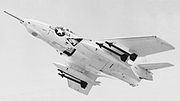 Variants
Variants
Picture: The F9F-8 was fitted with an inflight refueling probe and Sidewinder missiles.
XF9F-6
First three prototypes of the F9F Cougar
F9F-6
646 built; redesignated F-9F in 1962.
F9F-6P
60 were built for reconnaissance
F9F-6D
drone directors, converted from F9F-6s; redesignated DF-9F in 1962.
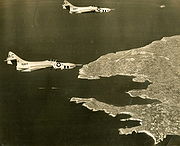 Picture:
Two F9F-8P from VFP-62 over Malta in 1958.
Picture:
Two F9F-8P from VFP-62 over Malta in 1958.
F9F-6K
unmanned drones for combat training, converted from F9F-6s; redesignated QF-9F in 1962.
F9F-6PD
drone directors, converted from F9F-6Ps; redesignated DF-9F in 1962.
F9F-6K2
an improved version of the F9F-6K target drone, converted from F9F-6s; redesignated QF-9G in 1962.
F9F-7
168 were built with the Allison J33 engine; most were converted to take J48s; redesignated F-9H in 1962.
F9F-8
601 aircraft; redesignated F-9J in 1962.
 Picture:
An F9F-6K drone in 1959
Picture:
An F9F-6K drone in 1959
YF9F-8B
Prototype for a single-seat attack-fighter aircraft converted from a F9F-8; later redesignated YAF-9J.
F9F-8B
F9F-8s converted into single-seat attack-fighters; later redesignated AF-9J.
F9F-8P
110 photo-reconnaissance versions.
YF9F-8T
one F9F-8 aircraft converted into a prototype for the F9F-8T training aircraft; later redesignated YTF-9J.
F9F-8T
377 two-seat trainers acquired; redesignated TF-9J in 1962.
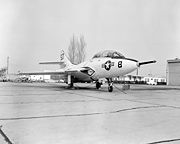 Picture:
A TF-9J of VMT-103 at MCAS El Toro in 1965
Picture:
A TF-9J of VMT-103 at MCAS El Toro in 1965
NTF-9J
Tw-TF-9Js used for special test duties.
YF9F-9
Original designation of the YF11F-1 Tiger protoypes. First flight was in 30 July 1954; redesignated in April 1955.
Specifications (F9F-8/F-9J)
General characteristics
-Crew: 1
-Length: 42 ft 2 in (12.9 m)
-Wingspan: 34 ft 6 in (10.5 m)
-Height: 12 ft 3 in (3.7 m)
-Wing area: 337 ft² (31.3 m²)
-Empty weight: 11,866 lb (5,382 kg)
-Loaded weight: 20,098 lb (9,116 kg)
-Max takeoff weight: 24,763 lb (11,232 kg)
-Powerplant: 1× Pratt & Whitney J48-P-8A turbojet, 8,500 lbf (38 kN) with water injection
Performance
-Maximum speed: 647 mph (1,041 km/h)
-Range: 1,312 mi (2,111 km)
-Service ceiling: 42,000 ft (12,800 m)
-Rate of climb: 5,750 ft/min (29.2 m/s)
-Wing loading: 61 lb/ft² (298 kg/m²)
Armament
-Guns: 4 × 20 mm (0.79 in) M2 cannon, 190 rounds per gun
-Rockets: 6 × 5 in (127 mm) rockets
-Missiles: 4× AIM-9 Sidewinder air-to-air missiles
-Bombs: 2 × 1,000 lb (454 kg) bombs
Aircraft on Display
There is an Fto 9J Cougar on display in the hangar deck of the USS Yorktown (CV-10) at thePatriot's Point Naval and Maritime Museum in Mount Pleasant,
SC.
Related development
-F9F Panther
-F-11 Tiger
Comparable aircraft
-F3H Demon
-F4D Skyray
References
1. Gordon Swanborough, Peter M. Bowers: United States Navy Aircraft since 1911. Naval Institute Press, Annapolis, Maryland (USA), pp. 249-251. ISBN
0-87021-792-5
2. External Link in Spanish with pictures
Living Warbirds: The best warbirds DVD series.
Source: WikiPedia